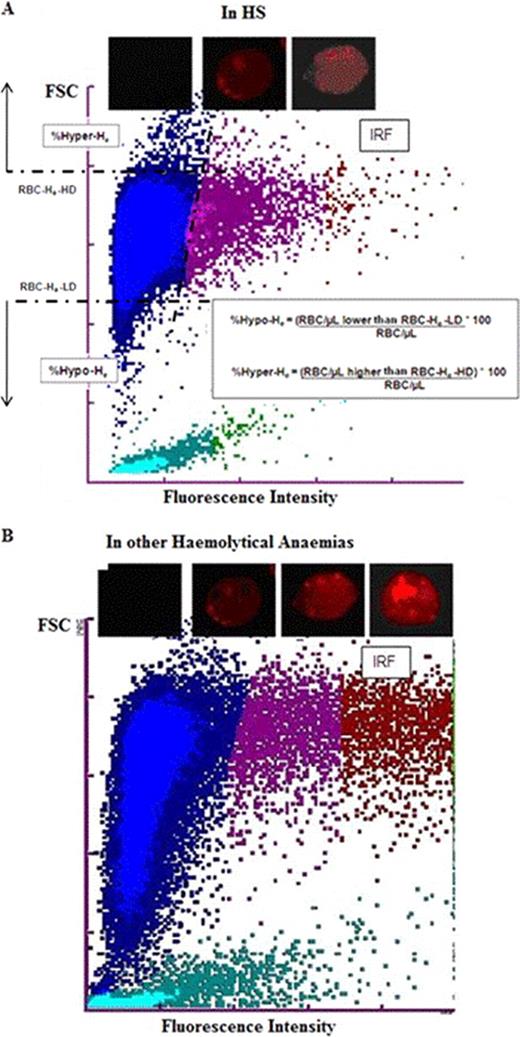Abstract
Abstract 2041
Hereditary Spherocytosis (HS) is characterized by weakened vertical linkages between the membrane skeleton and the red blood cells (RBC) lipid bilayer, leading to the release of microparticles (MPs). SDS-PAGE and ektacytometry are the two reference tests to establish the diagnosis. However, SDS-PAGE lacks sensitivity to very mild or asymptomatic HS carriers, and a high reticulocyte count might mask a reduction in ankyrin-1 in SDS-PAGE whereas an ankyrin-1 defect represents 40–65% of HS in the USA and Europe. Ektacytometry is only available in specialised laboratories. Consequently, diagnosis of HS is currently based on a combination of clinical and family histories, physical examination and laboratory data, especially RBC indices and sometimes a hypertonic cryohaemolysis test and eosin-5-maleimide binding in flow cytometry (EMA). Besides the release of MPs due to destabilisation of the lipid bilayer, one previous study showed that in HS, but not in AIHA, the surface area loss is already present at the circulating reticulocyte stage.
The aim of this study is to use the release of MPs at the reticulocyte stage to develop an algorithm on 2 haematological analysers: XE-2100 and XE-5000 (Sysmex) as simple, fast, accurate, sensitive, and specific diagnostic laboratory test for HS.
HgB, MCV, MCHC, Reticulocytes (Ret), Immature Reticulocytes Fraction (IRF), Hypochromic RBC (Hypo-He), Microcytic RBC (MicroR) and indices were determined using XE-2100 (n= 15) and XE-5000 (n= 30). %HYPO−He and %HYPER−He are specific to the XE−5000 (Figure 1). We first studied the efficiency of discordance between Ret and IRF on the XE-2100 and XE-5000, the MicroR/Hypo-He ratio on XE-5000 and the combination of those 2 rules forming an algorithm, to screen 45 confirmed HS (22 women, 23 men, mean age 13.1, from 1 day to 76 years old). They were classified as severe (n= 6, Hg <8g/dl), moderate (n= 27, Hg 8–12 g/dl) and mild (n= 12, Hg > 12g/dl). We then studied the efficiency of the algorithm to differentiate HS from other haemolytic disorders (n=108), microcytic RBC disorders (n=93), healthy subjects (n=61) and a routine database (n=1230).
HS is characterized by a high reticulocyte count (Ret) without an equally elevated Immature Reticulocytes Fraction (IRF) (Figure 1). The algorithm includes a precondition to screen all cases of HS, and a second rule taking into account the degree of anaemia. All 45 HS have reticulocytes > 80 G/l and a Ret (G/l)/IRF (%) ratio higher than 7.7. The second rule is different according to HgB level. All trait and mild cases of HS have a Ret/IRF ratio greater than 19. The efficiency of the algorithm to screen trait and mild HS is very interesting, as the diagnosis of trait and mild HS is currently difficult even by SDS-PAGE. The severity of the disease shown by HgB level is due to the intensity of release of MPs, which is reflected at best by MicroR. Thus, for moderate and severe cases, MicroR and MicroR/Hypo-He were combined. The optimal cut-offs for MicroR and MicroR/Hypo-He in cases of HgB between 8 and 12 g/dl, were 3.5% and 2.5 respectively and if HgB was lower than 8 g/dl, were 3.5% and 2.0 respectively. Interestingly, the algorithm was also valid for the 4 neonates and the 4 cases of ABO incompatibility patients. We also showed that this algorithm is much more performant than single parameters (Ret/IRF index) or the existing rules (reticulocytosis, % microcytes, combination of increased Mean Corpuscular Haemoglobin Concentration (MCHC) with increased red distribution width (RDW), combination of increased RDW with hyperdense cells (Hyperchromic cells), combination of increased MCHC with increased hyperdense cells). The Area Under the Curve (AUC), sensitivity, specificity, predictive positive value (PPV) and negative predictive value (NPV) were respectively 0.997, 100%, 99.3%, 75% and 100% for the HS algorithm. Finally, preliminary data on a small group of patients indicate that HS induced the release of significantly more RBC MPs than healthy subjects, paroxysmal nocturn hemoglobinuria and heparin-induced thrombocytopenia.
We have developed a simple and inexpensive algorithm that could be used as an excellent screening device for the diagnosis of HS. This rapid algorithm also works on mild HS, ABO incompatibilities, neonates and overcomes the lack of sensitivity of SDS-PAGE in ankyrin deficiencies.
No relevant conflicts of interest to declare.
Author notes
Asterisk with author names denotes non-ASH members.


This feature is available to Subscribers Only
Sign In or Create an Account Close Modal